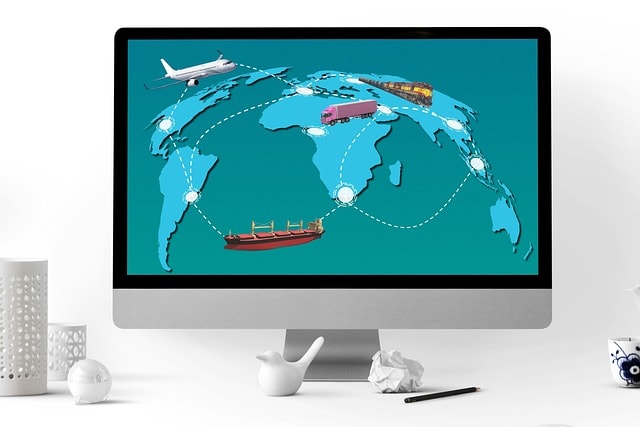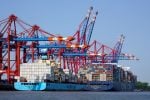In 2025, I came across a surprising fact. More than 60 percent of businesses that tried to expand internationally failed in their first year. It wasn’t because their products lacked quality or because customers in other countries didn’t want them. They failed because they struggled to move their products across borders efficiently, and that ended up hurting their international trade.
From what I’ve seen, international logistics isn’t just about shipping boxes from one country to another. It’s the hidden factor that decides whether my logistics efforts and partners help turn my business into a global success or just another failed statistic.
Think about this: Right now, a small company in Minnesota is selling handcrafted furniture to customers in Tokyo. A startup in Portugal is delivering fresh pastries to stores in Brazil within 48 hours of baking. A one-person business in South Africa is competing with industry giants in European markets.
What separates these success stories from the failures?
They all discovered something critical: international logistics works as more than just a necessary expense—it’s a strategic advantage that can transform your business.
When you master international logistics, borders become opportunities rather than barriers. Your supply chain becomes shorter, not longer. Your costs decrease instead of multiplying, allowing you to reduce costs significantly. Your customer base expands exponentially rather than incrementally.
But here’s what most business owners don’t understand: the rules of global trade are changing faster than ever before. Customs regulations shift monthly. Shipping routes evolve weekly. Technology transforms logistics capabilities daily.
This guide cuts through the complexity. We’ll walk through exactly how international logistics helps your business grow beyond borders—from the basics of cross-border supply chains to advanced freight forwarding techniques that can give you a competitive edge.
Boost customer satisfaction with just a few clicks
Most-Loved Features:
- On-demand drivers
- Real-time GPS tracking
- Delivery confirmation photos
- Over 50% of customers report a smoother delivery experience
What is International Logistics?
-
International logistics manages the movement of goods across borders through multiple transportation methods.
-
It requires expertise in customs regulations, documentation, and global supply chain coordination.
-
Essential for businesses looking to expand globally and reach international customers efficiently
International logistics refers to the planning, implementation, and control of key elements such as goods, services, and information across international borders. It’s the backbone of global trade that ensures products manufactured in one country can reach customers in another with minimal delays and costs. Unlike domestic logistics, international operations must navigate complex regulatory environments, multiple currencies, language barriers, and varying transportation infrastructures.
At its core, international logistics involves coordinating several key elements: transportation selection (air, ocean, rail, or road), inventory management across global locations, warehousing in strategic international hubs, packaging that meets international standards, and documentation that satisfies customs requirements in different countries.
The scope of international logistics has expanded dramatically since 2020. Global trade value reached $32 trillion in 2024, creating massive demand for efficient cross-border logistics solutions. Companies no longer view international logistics as simply moving goods between countries—it’s now a strategic function, an international logistics strategy that can provide competitive advantages through cost reductions, faster deliveries, and improved customer satisfaction.
Examples of International Trade Logistics For Physical Goods
International logistics appears in countless forms across global trade. A clear example is the smartphone in your pocket. Its components likely came from over a dozen countries before final assembly. Each part required careful logistics coordination to arrive at the right place at the right time.
Consider a fashion retailer based in the United States that manufactures clothing in Bangladesh. The international logistics process begins with raw material procurement (possibly from multiple countries), followed by production in Bangladesh. Once manufactured, the goods are packed according to U.S. import requirements and transported to a port. Ocean freight carries the containers across the Pacific, where they clear U.S. customs. Trucks then deliver the shipments to distribution centers, and finally to retail stores or directly to customers. Throughout this journey, the retailer must manage inventory effectively:
-
Export permits and documentation from Bangladesh
-
International shipping insurance and cargo security measures
-
U.S. customs clearance and duty payments
-
Compliance with textile import regulations
-
Tracking and tracing throughout the entire journey
Another example is automotive manufacturing. A German car manufacturer might source electronic components from Japan, rubber from Thailand, steel from South Korea, and assemble vehicles in Mexico for sale in North America. This requires precise coordination of logistics to the Mexican plant, production scheduling, and outbound distribution networks. Delays at any point—perhaps due to customs issues or documentation errors—can halt production lines and cost millions.
Types of International Transport Logistics Services
Freight Forwarding
Freight forwarders act as intermediaries between shipping companies and businesses. They don’t typically own transportation assets but arrange the most efficient routes and rates for international shipments. Their value comes from expertise in documentation, regulations, and relationships with carriers.
A good freight forwarder will analyze your shipping needs and recommend the optimal transportation methods. For instance, they might suggest sea freight for bulky, non-urgent items and air freight for time-sensitive deliveries. They negotiate with multiple carriers to secure competitive rates that help save money for individual shippers who couldn’t access such options on their own.
The documentation assistance provided by freight forwarders is particularly valuable. They prepare and process bills of lading, commercial invoices, certificates of origin, dangerous goods declarations, and other paperwork required for international shipping. Errors in these documents can lead to delays, penalties, or even shipment rejection at customs.
Customs Brokerage
Customs brokers specialize in clearing goods through customs barriers and ensuring compliance with import and export regulations. They have detailed knowledge of tariff codes, duty rates, trade agreements, and country-specific requirements that most businesses lack internally.
Customs brokers submit necessary documentation to government authorities, calculate and pay duties and taxes on behalf of importers, and work to resolve any issues that arise during clearance. Their expertise in customs procedures helps prevent costly delays and compliance problems.
For example, when importing electronics into the European Union, a customs broker would:
-
Determine the correct Harmonized System (HS) classification codes
-
Calculate VAT and any applicable duties
-
Ensure compliance with CE marking requirements
-
Prepare and submit the Single Administrative Document (SAD)
-
Arrange for physical inspections if required
Beyond basic clearance, customs brokers often provide consulting services on trade regulations, free trade agreement qualifications, and duty minimization strategies. This advisory role has grown more valuable as global trade rules have become increasingly complex.
Benefits of International Logistics Works
-
International logistics connects businesses to global markets, customers, and suppliers.
-
Proper implementation leads to better efficiency, lower costs, and a competitive advantage.
-
Modern technology integration has transformed international logistics from a necessity to a strategic asset.
International logistics has evolved from simply moving goods across borders to becoming a competitive advantage for businesses looking to grow globally. Companies that master international logistics gain access to new markets, diverse supplier networks, and opportunities to stay competitive for business expansion in the global marketplace, which includes other countries that would otherwise remain unreachable.
When implemented correctly, international logistics transforms from a cost center into a strategic asset that drives business growth. Research from the Council of Supply Chain Management Professionals shows that companies with sophisticated international logistics capabilities typically outperform their competitors in market share growth and profitability margins by 12-15%.
Improved International Supply Chain Management
International logistics excellence directly enhances supply chain management by connecting the various elements of global operations into a cohesive system. When a business operates across multiple countries, the supply chain naturally becomes more complex with additional touchpoints, regulations, and potential failure points. Effective international logistics addresses these challenges by creating standardized processes that work across different regions.
A key benefit is the ability to create visibility throughout the entire supply chain. Advanced tracking systems using GPS, RFID, and IoT technologies allow companies to monitor shipments in real-time regardless of where they are in the world. This transparency helps businesses identify bottlenecks, prevent delays, and respond quickly to disruptions by providing relevant information. For example, during supply chain disruptions in 2022, companies with end-to-end visibility were able to respond 35% faster than those without such capabilities.
The standardization of logistics processes across international operations also reduces variability and improves consistency. When a company implements uniform procedures for documentation, shipping, and receiving across all global locations, it minimizes errors and creates predictability. This standardization allows for better planning, more accurate forecasting, and ultimately a more reliable supply chain that customers can depend on.
Data-Driven Decision Making
International logistics generates massive amounts of data that, when properly analyzed, provides valuable insights for supply chain optimization. Companies can use this data to make evidence-based decisions about inventory levels, transportation modes, and supplier selection, while avoiding potential pitfalls.
The data collected through international logistics operations helps businesses identify patterns and trends that might not be obvious without a global perspective. For example, a company might discover seasonal demand variations across different regions that can be leveraged to balance production and distribution resources throughout the year. This global view enables more sophisticated supply chain strategies than would be possible with a single-market focus.
Cost Efficiency of International Shipping
One of the most significant benefits of well-managed international logistics is cost reduction across the supply chain. By optimizing transportation routes, consolidating shipments, and selecting the most appropriate modes of transport at the right price, businesses can substantially lower their shipping expenses. Companies that master international logistics typically reduce their shipping costs by 15-20% compared to those with less sophisticated approaches.
International logistics also enables inventory optimization on a global scale. With reliable shipping times and accurate tracking, businesses can maintain lower safety stock levels without risking stockouts. This reduction in inventory carrying costs also incorporates reverse logistics, freeing up capital that would otherwise be tied up in excess inventory. Some global retailers have reported inventory reductions of 20-30% after implementing advanced international logistics systems.
The scale of international operations also creates opportunities for cost savings through volume discounts and negotiating power. By consolidating shipping volumes across multiple regions, businesses can secure better rates from carriers and service providers. These economies of scale are particularly valuable for mid-sized companies that might not have sufficient volume in their domestic market alone to command competitive rates.
Access to New Markets and Customers
International logistics makes it possible for businesses to reach customers anywhere in the world, dramatically expanding their potential market. This global reach is particularly valuable for companies in smaller domestic markets with limited growth potential. By removing the barriers to international sales, effective logistics ensures that goods reach their final destination, turning the entire world into a potential marketplace.
Beyond just enabling sales to international customers, sophisticated logistics allows businesses to adapt their offerings to local market needs. For example, companies can establish regional distribution centers that stock products tailored to local preferences, with delivery times comparable to local competitors. This capability to serve international markets with locally relevant offerings and competitive service levels helps meet customer demand and is a powerful growth driver.
Risk Mitigation and Business Continuity
International logistics provides natural diversification that helps businesses manage risk. By operating across multiple regions with different suppliers, transportation routes, and distribution networks, even if they are in the same country, companies become less vulnerable to disruptions in any single location. This geographic diversification proved especially valuable during recent global supply chain challenges.
Advanced international logistics systems include contingency planning and alternative routing capabilities that maintain business continuity during disruptions. Companies with sophisticated international logistics were able to quickly reroute shipments and find alternative suppliers during recent port congestions, container shortages, and regional lockdowns.
The risk mitigation benefits extend beyond physical disruptions to include financial and regulatory risks as well. International logistics expertise helps businesses navigate currency fluctuations, trade disputes, and changing regulations that could otherwise create significant challenges for global operations.
Competitive Advantage and Strategic Growth in International Logistics
Perhaps the most important benefit of international logistics is its ability to create a sustainable competitive advantage. When a business can deliver products to international customers faster, more reliably, and at lower cost than competitors, it gains significant market advantages and improved operational efficiency that are difficult to replicate.
For manufacturers, international logistics enables access to specialized suppliers worldwide, improving product quality and innovation potential. Rather than being limited to domestic suppliers, companies can source components and materials from the best providers globally, driving product improvement and differentiation.
International logistics also creates opportunities for strategic partnerships and joint ventures that would otherwise be impractical. When companies can reliably move goods between different operations, they can establish manufacturing partnerships, distribution agreements, and other collaborative arrangements that create mutual benefits across borders.
The international logistics expertise developed through international operations often becomes a valuable capability in itself. Some companies have turned their international logistics knowledge into new business opportunities, such as providing electronic bill solutions in logistics services to other firms or developing technology solutions based on their operational experience.
The benefits of international logistics extend far beyond simply moving goods from one country to another. They represent a fundamental capability that transforms how businesses operate globally, creating opportunities for growth, efficiency, and competitive advantage that would otherwise be impossible to achieve.
How Does Cross-Border Supply Chain Work?
-
Cross-border supply chains connect global operations through the strategic coordination of materials, production, and shipping.
-
Technology integration enables real-time visibility and communication between international partners.
-
Successful implementation requires careful navigation of regulations, customs procedures, and localization requirements.
Cross-border supply chains form the backbone of global commerce, enabling businesses to source materials, manufacture products, and distribute goods across multiple countries. These complex networks don’t simply happen—they require careful orchestration of various elements working in harmony. The modern cross-border supply chain combines physical movement of goods with digital information flows, creating an interconnected system that spans continents.
At its core, cross-border supply chain management involves balancing cost efficiency, speed, and compliance requirements while maintaining quality standards across diverse operating environments. Companies that master these complex networks gain significant advantages in global markets, from accessing cheaper materials to reaching new customer segments.
Step #1: Sourcing and Procurement
Global sourcing involves finding and securing materials and components from international suppliers. This critical first step in cross-border supply chains has evolved dramatically since the early 2000s, with businesses increasingly looking beyond domestic sources to access better pricing, unique materials, or specialized manufacturing capabilities.
Effective international procurement begins with supplier identification and evaluation. Companies use specialized databases like Panjiva and Import Genius to find potential suppliers and business partners, examining their production capabilities, quality standards, and financial stability. Organizations often conduct site visits to verify facilities and capabilities firsthand.
Price negotiation in global sourcing differs significantly from domestic procurement. Beyond basic price points, companies must consider currency fluctuations, international payment terms, and total landed costs including freight, duties, and taxes. Many organizations employ strategies like forward contracts to hedge against currency risks when dealing with suppliers in volatile markets.
Supplier Relationship Management Across Borders
Building strong supplier relationships across cultural and geographic boundaries presents unique challenges. Western companies often approach supplier relationships with contract-focused mindsets, while suppliers in regions like Asia may place greater emphasis on personal relationships and long-term commitments. Successful global procurement teams recognize these differences and adapt their approach accordingly.
Regular communication through digital channels has become essential for maintaining these relationships. Video conferencing, shared digital platforms, and collaborative supply chain management software help bridge the physical distance. The Aberdeen Group found that companies using digital supplier collaboration tools experienced 85% fewer supply disruptions than those relying on traditional communication methods.
Step #2: Manufacturing and Production
Manufacturing strategy in cross-border supply chains involves decisions about where products are made and how production is coordinated across multiple facilities. These decisions balance numerous factors, including labor costs, proximity to markets, tax implications, and access to specialized skills or technologies.
Companies typically employ one of several global manufacturing models. Some use centralized production, manufacturing in a single location, and shipping worldwide. Others adopt regional manufacturing hubs serving specific parts of the world. Increasingly popular is the distributed manufacturing model, where different components are produced in various locations based on local advantages, then assembled closer to end markets.
Production planning across international facilities requires sophisticated coordination. Companies must account for longer lead times, varying production capabilities, and potential disruptions when scheduling across borders. Advanced planning and scheduling (APS) systems have become essential tools, enabling companies to optimize production across multiple facilities. Research by Gartner indicates that organizations using these systems achieve 15-20% higher production efficiency in multi-site operations compared to those using traditional planning methods.
Local Adaptation vs. Global Standardization
A key tension in global manufacturing involves balancing standardization with localization. Standardized production processes and product specifications reduce complexity and enable economies of scale. However, local regulations, market preferences, and available resources often necessitate adaptations.
Quality control presents particular challenges when manufacturing spans multiple countries with different standards and practices. Leading companies implement globally consistent quality management systems while accounting for local variations in implementation. Regular audits, standardized testing protocols, and centralized quality data collection help maintain consistent standards and effective reverse logistics across diverse manufacturing locations.
Step #3: International Transportation and Logistics
Moving goods across borders represents one of the most visible aspects of cross-border supply chains. This step encompasses selecting appropriate transportation modes, managing documentation, and ensuring goods clear customs efficiently at borders.
Transportation mode selection in international logistics involves weighing tradeoffs between speed, cost, and reliability. Air freight offers rapid delivery but at premium prices, typically 5-6 times higher than ocean shipping. Ocean freight provides cost advantages for bulky items but requires longer transit times, typically 2-4 weeks for major routes. Rail transport, particularly along routes like China’s Belt and Road Initiative, offers an intermediate option, gaining popularity for Eurasian shipments.
Intermodal transportation, combining multiple modes in a single journey, has become increasingly sophisticated in cross-border supply chains. Goods might travel by truck to a port, cross oceans in containers, then transfer to rail for inland movement. The seamless transfer between modes requires standardized container systems and coordinated logistics planning.
Documentation management represents a critical but often overlooked aspect of international transportation. Each shipment requires numerous documents, including commercial invoices, certificates of origin, packing lists, and bills of lading. Errors or omissions in these documents can cause significant delays. Digital documentation systems and blockchain technologies are transforming this aspect of cross-border logistics, reducing processing times and error rates.
Customs Clearance and Compliance
Navigating customs procedures efficiently is essential for maintaining smooth cross-border flows. Each country has unique requirements, tariff schedules, and restricted items lists that shippers must understand. Customs compliance goes beyond paperwork—it requires strategic planning and sometimes restructuring of supply chains.
Tariff engineering has emerged as a sophisticated practice, where companies design products and supply chains specifically to optimize customs treatment. This might involve breaking manufacturing processes across countries to take advantage of preferential trade agreements or modifying product specifications, which can be time-consuming to achieve more favorable tariff classifications.
Advanced filing requirements have become standard in most major economies, requiring shipment information to be submitted electronically before goods arrive at borders. Programs like the U.S. Customs and Border Protection’s Automated Commercial Environment (ACE) and the European Union’s Import Control System (ICS) demand detailed advance information. Companies that master these systems gain significant advantages in border crossing speed.
Step #4: International Distribution and Fulfillment
Once goods have crossed borders to other countries, they must be efficiently distributed to end customers through warehousing, order fulfillment, and last-mile delivery networks. This step has transformed dramatically with the rise of e-commerce and consumer expectations for rapid delivery.
Distribution network design in cross-border supply chains involves strategic decisions about warehouse locations and inventory positioning. Many companies adopt hub-and-spoke models with regional distribution centers serving multiple countries. Others use country-specific facilities to enable faster delivery to the final destination and compliance with local requirements. Factors influencing these decisions include delivery time requirements, inventory carrying costs, local regulations, and return processing needs.
Inventory management becomes particularly complex in international distribution. Companies must balance having sufficient stock to meet local demand against the costs of maintaining duplicate inventories across markets. Advanced inventory optimization systems use machine learning algorithms to predict regional demand patterns and recommend optimal stock levels for each location. Research from McKinsey found that companies using AI-driven inventory optimization in international markets reduce inventory costs by 10-30% while maintaining or improving service levels.
Localization and Country-Specific Requirements
Successful international distribution requires attention to local market requirements and consumer preferences. This includes adapting packaging to local languages and regulatory standards, modifying product assortments based on regional preferences, and implementing country-specific pricing strategies.
Payment methods vary significantly across markets, with credit cards dominating in North America and Europe while mobile payments lead in parts of Asia and Africa. Companies must offer locally preferred payment options to succeed in each market. Similarly, return policies and processes must be adapted to local consumer expectations and regulations.
Environmental regulations increasingly impact international distribution operations. Extended Producer Responsibility (EPR) laws in Europe require manufacturers to manage the end-of-life disposal of products and packaging. Similar regulations are emerging globally, requiring companies to develop market-specific compliance strategies for product takeback and recycling.
Step #5: Cross-Border Data Management and Visibility
The invisible flow of information paralleling physical goods movement has become equally critical in modern cross-border supply chains. Data management systems provide the visibility and tracking information necessary to maintain a smooth flow for managing complex international operations.
Supply chain visibility platforms integrate data from multiple sources—suppliers, carriers, customs agencies, and warehouses—to provide real-time information about inventory locations and movement status. These systems have evolved from basic track-and-trace capabilities in different countries to sophisticated control towers that enable proactive management of international flows.
The most advanced systems now incorporate Internet of Things (IoT) sensors that monitor not just location but also conditions like temperature, humidity, and shock exposure during international transit. This capability is particularly valuable for sensitive products like pharmaceuticals and electronics.
Integration between systems across international partners presents significant technical challenges. Different countries often use different data standards, communication protocols, and technology infrastructure. Application Programming Interfaces (APIs) and cloud-based platforms have emerged as solutions, enabling standardized data exchange between diverse systems. s.
Analytics and Decision Support for Global Operations
The wealth of data generated by modern cross-border supply chains enables sophisticated analytics that support better decision-making. Predictive analytics identifies potential disruptions before they impact operations, while prescriptive analytics recommends specific actions to optimize performance.
Supply chain digital twins—virtual replicas of physical supply chains—allow companies to simulate different scenarios and test strategies before implementation. These models incorporate geographical data, transportation networks, customs procedures, and market demand patterns to accurately represent cross-border operations. According to research by Deloitte, companies using digital twins for international supply chain planning, in collaboration with major carriers, reduce their planning cycle times by 50-70% while improving plan accuracy.
Blockchain technology is transforming information sharing in cross-border supply chains by providing secure, tamper-proof records accessible to all authorized parties. Applications include verified certificates of origin, secure trade documentation, and traceable product provenance. While still emerging, blockchain implementations have shown promise in reducing documentation processing times by 40-80% in international shipping pilot projects.
Cross-Border Supply Chain Challenges and Solutions
Despite technological advances, cross-border supply chains face persistent challenges that require both operational and strategic solutions. Understanding these challenges helps companies develop more resilient international operations.
Regulatory complexity remains a primary obstacle, with each country imposing unique rules regarding product standards, labeling requirements, and import procedures. Companies address this through specialized compliance teams and regulatory intelligence systems that track changes in relevant regulations. The most sophisticated organizations build regulatory considerations directly into product design and supply chain planning processes.
Cultural and language differences create coordination challenges across international supply chain partners. Beyond basic translation, these differences manifest in communication styles, business practices, and expectations. Successful global companies invest in cross-cultural training and establish clear communication protocols that accommodate different working styles.
Security concerns have intensified in recent years, with threats ranging from cargo theft to cyberattacks on supply chain information systems. Organizations respond with layered security approaches, combining physical security measures with advanced digital protections. Participation in security programs like the Customs-Trade Partnership Against Terrorism (C-TPAT) in the U.S. or the Authorized Economic Operator (AEO) program in the European Union can also expedite border crossings while enhancing security.
Supply chain resilience has become a top priority, particularly after recent disruptions from the pandemic, geopolitical tensions, and natural disasters. Companies build resilience through strategies like supplier diversification, strategic inventory positioning, and flexible transportation arrangements.
International Logistics Process For Global Trade Businesses
Expanding your business internationally isn’t just about shipping products—it’s about creating global connections that fuel growth. Through strategic international logistics, your ecommerce businesses can tap into new markets while maintaining cost efficiency and streamlined operations. The tools we’ve explored—from freight forwarding to customs brokerage services—provide the framework for crossing borders with confidence.
Success in global trade requires careful attention to compliance, reliable shipping partners, and data-driven decision making. By implementing digital platforms and predictive analytics, you can stay ahead of market demands and optimize your supply chain across continents. To further enhance your international logistics capabilities, focusing on efficient supply chain order management is essential. Optimizing order management ensures that customer demands are met promptly while minimizing inventory costs and errors, leading to greater overall operational efficiency. For a detailed approach on enhancing this critical aspect, explore strategies in effective supply chain order management practices.
Remember that quality assurance and local market insights are your allies in building a lasting international presence. Each step you take to improve your logistics capabilities strengthens your business foundation for global growth.
As you implement these strategies, your business won’t just ship products worldwide—it will build lasting relationships with customers across borders, creating sustainable growth opportunities that domestic operations alone cannot match. The world is waiting for what you offer. With the right logistics approach, there’s no limit to how far your business can go.














